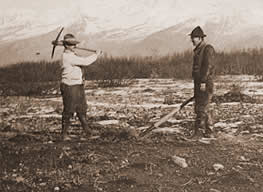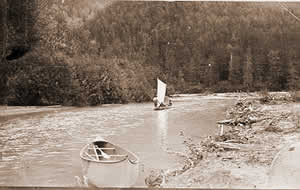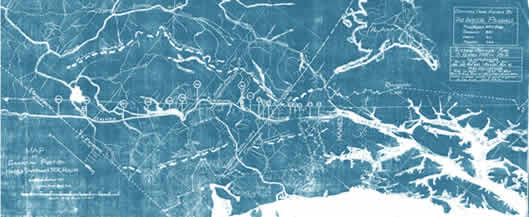With only a little imagination one can bring alive a 12×28-inch blueprint of the Haines to Fairbanks Railroad Route on display at the Sheldon Museum and Cultural Center. Signed by H. P. M. Birkinbine in April 1914, it sketches a project begun four years earlier as a dream of financier John Rosene and a group of surveyors to push the Alaska Midland Railroad from Haines to Fairbanks.
Headlines in the Haines Pioneer Press during 1913 observed that “From Puget Sound to Fairbanks via Haines eliminates the open ocean and saves 330 miles.”Since other communities were beginning to push for a railroad to the Interior, the advantage of Haines’ connection with the Inside Passage was important, and Haines was the only Southeast community requesting approval by the U. S. Congress.
The Haines Chamber of Commerce wrote directly to President Woodrow Wilson about the advantages of the Haines-Fairbanks route over those of Cordova and Seward. Alas, Seward sent a delegation of business people to Washington to plead their case in person, which apparently proved more forceful than correspondence. On June 21, the newspaper reported that the Alaska Railroad bill before Congress provided “for the construction of three roads with terminals at Seward, Cordova, and Controller Bay at Katella, extending to the Yukon River and the Bering and Matanuska coal fields.” The railroad actually built was much less extensive with Seward as its terminus.

H.P.M.Birkinbine (left) and Steve Sheldon (right) on the midland railroad survey.
By November 1910, the survey team had reported that from Isobel Pass to Wells there was a grade of only one and one-half percent, and the high point of the pass was 2,735 feet. Early plans discussed crossing the Bering Strait, either by bridge or by a tunnel, to connect the railroad with the Siberian railroad.
In 1911, Rosene studied the Swiss monorail system at Brennan for a design to build spurs for the Porcupine and Rainy Hollow District on his railroad. He thought the monorail system could even be used across the pass.
In the fall of 1911, the survey team of John Rosene, H. R. Robbins, H. P. M. Birkinbine, Steve Sheldon, and Gus Klaney returned to Haines, and Rosene reported that “the building of a railroad through this territory would be an easy undertaking.” Much of the route could be laid on a straight line with little grade but the crew encountered stretches of tangled brush that had to be cleared by hand.

A stream along the midland railroad survey. **more**
Rosene envisioned the opening of a rich mineral deposit in Alaska and Canada and shortened travel time between Seattle and Fairbanks. “It would be but a 24-hour trip from Haines on into Fairbanks, a distance of 750 miles,” he wrote. It is reported that he raised two million dollars for the construction of his railroad. He even foresaw possibilities of great farming country opening up.
The government decision in 1913 to support the railroad to Seward did not immediately dampen local enthusiasm for the Haines-Fairbanks project. Backers believed they might find private support. The small blueprint on display is the one carried by Birkinbine the following year as he went to potential shippers to show them advantages of the Alaska Midland Railroad.
The US government showed that it did not support railroad construction across Canada, and it was the period when the rich coal fields of the territory had been bottled up by a growing national conservation policy, but what other political and commercial considerations thwarted the railroad plan are not known.
The dream seemed shattered as America was drawn into World War I. By another generation and another war Haines would have its link with the Interior through the Haines Cut-off Highway, which joins the 1,520-mile Alcan Highway built by the U.S. Army in a little over eight months during 1942. Just surveying the Alaska Midland Railroad project took about two years.
Doris Ward, 1987

